Abstract
Fundamental movement competency is essential for participation in physical activity and for mitigating the risk of injury, which are both key elements of health throughout life. The squat movement pattern is arguably one of the most primal and critical fundamental movements necessary to improve sport performance, to reduce injury risk and to support lifelong physical activity. Based on current evidence, this first (1 of 2) report deconstructs the technical performance of the back squat as a foundation training exercise and presents a novel dynamic screening tool that incorporates identification techniques for functional deficits that limit squat performance and injury resilience. The follow-up report will outline targeted corrective methodology for each of the functional deficits presented in the assessment tool.
Keywords: functional deficit identification, injury prevention, physical activity, screening tool, sport performance, squat
INTRODUCTION
Fundamental movement skills are essential for participation in physical activity and mitigating the risk of injury, which are both key elements of health throughout life.(25) Young people, for example, without adequate motor skill proficiency in the early developmental years may experience a heightened risk of sports-related injuries during adolescence and into adulthood.(11, 32, 34) Thus, development of competence in fundamental movements must be viewed as an essential component of preparatory training prior to vigorous physical activity and organized, competitive sport. Some fundamental movement patterns include running, throwing, lunging, and squatting,(25) and these fundamental movements have direct biomechanical and neuromuscular implications to successful performance with dynamic tasks inherent to many popular sports and physical activities enjoyed by youth and young adults.(24, 35) Movement competency as a principle extends through into the later adult years, for whom the joy of independent living rests on their ability to maintain strength and mobility to avoid injuries such as falling.(44)
The squat movement pattern is required for essential activities of daily living such as sitting, lifting and most sporting activities. It is also a staple exercise in training regimens designed to enhance performance and to build injury resilience.(30–32) Despite variations on how squat technique is instructed and executed to address specific performance goals, nearly all squat variations comprise a standard, basic, and fundamental blueprint that underlies the biomechanical technique that will support progressive physical attribute improvements and decrease the risk of training induced injuries.(3) In addition, the unloaded back squat (herein referred to as “back squat”) has been proposed for use as a screening tool to identify biomechanical deficits that may hinder optimal movement patterns compromising performance and injury resilience.(20) In particular, the back squat can be used to assess an individual for neuromuscular control, strength, stability, and mobility within the kinetic chain.(1, 4, 10, 31, 39, 42)
The purpose of this commentary is to deconstruct the technical performance of the back squat and the related evidence, as both a foundation training exercise and dynamic screening tool. Specifically, we aim to describe common functional deficits during back squat performance known to increase injury risk during training and dynamic sport. Identified deficits and injury mechanisms will be formalized together with anatomical variations that influence squat kinematics and kinetics. In the follow-up manuscript, we aim to present detailed targeted training exercises and techniques to correct biomechanical deficits, (Part II) which is vital to improve the technical skill and competence of the back squat.(22) Achieving this competency is the foundation for younger individuals to partake in training progressions that enhance performance and injury resilience, and for older adults to live independently and safely.(25)
The Back Squat
The back squat is widely regarded as one of the most effective exercises used to enhance athletic performance as it necessitates the coordinated interaction of numerous muscle groups and strengthens the prime movers needed to support explosive athletic movements such as jumping, running, and lifting.(7) Furthermore, back squat proficiency supports derivative squat movements that translate to many everyday tasks such as lifting and carrying heavy objects, which relates this exercise to improve quality of life.(43) The squat has also become more commonly used in clinical settings to strengthen lower-body musculature (especially posterior chain strength and recruitment patterns) with little to no harm on connective tissue after joint-related injury.(7, 43) Specifically, closed kinetic chain exercise is commonly used throughout the rehabilitation process to avoid excessive strain being placed on the anterior cruciate ligament (ACL), making the squat a favorable exercise for rehabilitation.(7, 17, 37, 43). It is highly recommended that an individual is first able to demonstrate proficiency during body weight back squat performance before advancing to more intense variations and derivatives of squatting such as externally loaded squats and plyometric training.
The back squat exercise is most often prescribed with an individual starting in a standing position with the feet flat on the floor, the knees and hips in a neutral, extended anatomical position, and the spine in an upright position with preservation of its natural curves.(7, 43, 45) The squat movement begins with the descent phase as the hips, knees, and ankles flex. A common instruction is to descend until the top of the thigh is at least parallel with ground and the hip joint is at least level with or slightly below the knee joint (Figure 1).(3, 43) Ascent is achieved primarily through triple extension of the hips, knees, and ankles, continuing until the subject has returned to the original extended, starting position.(3) The posterior torso muscles, particularly the erector spinae, are recruited via isometric muscle action to support an upright posture throughout the entire squat movement. Furthermore, the posterior torso muscles are assisted by the anterior and lateral abdominal muscles to further stiffen the torso by creating tension for the abdominal wall.
Figure 1.
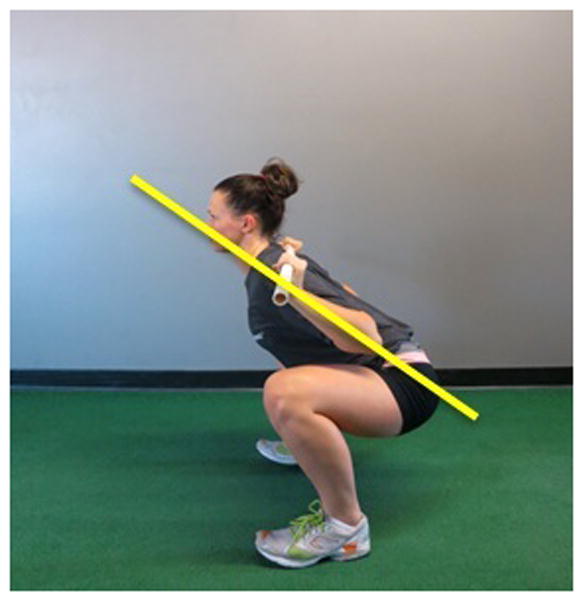
a. Squat starting position and b. recommended squat depth.
Prior to the initiation of the descent phase, it is recommended for the athlete to inhale approximately 80 percent of maximal inhalation and hold their breath to increase intra-abdominal pressure to enhance stability of the vertebral column (i.e., Valsalva maneuver) (Note: This amount of air may change with the load magnitude). This technique prepares the spine, which is a flexible rod, to bear compressive load. The Valsalva maneuver also establishes “proximal stiffness” that enables more power development in the shoulders and hips, enhancing limb force output and velocity.
Identification of Biomechanical Deficits during the Back Squat
The basic squat movement is considered by many professionals to be a valuable primary physical training exercise since it is a single compound maneuver that is highly sensitive to highlight biomechanical deficits.(12, 13, 33, 42) Deficits identified during the back squat that can impair performance can be categorized as either inefficient motor unit coordination or recruitment (neuromuscular), muscle weakness, strength asymmetry or joint instability (strength), and/or joint immobility or muscle tightness (mobility).(43) It is important to identify the biomechanical and anatomical limitation(s) that most egregiously underlies aberrant movements in order to ameliorate identified deficit(s) through an appropriate and effective targeted corrective strategy (Part 2).(12, 13, 33, 42) With the use of the proposed Back Squat Assessment (BSA) screening tool (Table 1), a practitioner may be able to more efficiently and objectively identify underlying deficit(s) responsible for functional limitations during back squat performance and to guide corrective targeted exercise progressions.
Table 1.
The Back Squat Assessment
| Criteria | Description | Correct | Incorrect | Deficit | Type | Comments | |
|---|---|---|---|---|---|---|---|
| Domain 1: Upper Body | |||||||
| ➀ | Head Position: | Line of neck is perpendicular to the ground and gaze is aimed forward. |
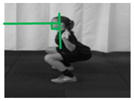
|
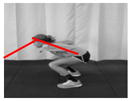
|
□ | Neuromuscular Strength Mobility |
|
| ➁ | Thoracic Position: | Chest is held upward and shoulder blades are retracted. |
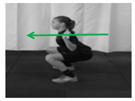
|
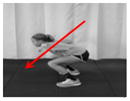
|
□ | Neuromuscular Strength Mobility |
|
| ➂ | Trunk Position: | Trunk is parallel to tibia, while maintaining slightly lordotic lumbar spine. |

|

|
□ | Neuromuscular Strength Mobility |
|
| Domain 2: Lower Body | |||||||
| ➃ | Hip Position: | Line of hips is parallel to ground in frontal plane throughout squat. |
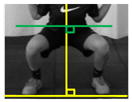
|
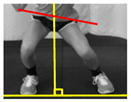
|
□ | Neuromuscular Strength Mobility |
|
| ➄ | Frontal Knee Position: | Lateral aspect of knee does not cross medial malleolus for either leg. |
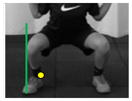
|
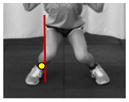
|
□ | Neuromuscular Strength Mobility |
|
| ➅ | Tibial Progression Angle: | Knees do not excessively pass the front of the foot. Tibias are parallel to an upright torso. |
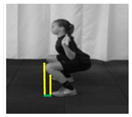
|
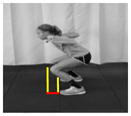
|
□ | Neuromuscular Strength Mobility |
|
| ➆ | Foot Position: | Entire foot remains in contact with the ground. |

|
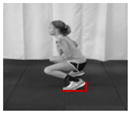
|
□ | Neuromuscular Strength Mobility |
|
| Domain 3: Movement Mechanics | |||||||
| ➇ | Descent: | Utilizes hip-hinge strategy at a controlled, constant speed throughout descent. Torso remains upright. |
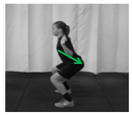
|
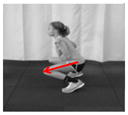
|
□ | Neuromuscular Strength Mobility |
|
| ➈ | Depth: | At apex of depth, the tops of thighs are at least parallel to the ground. |
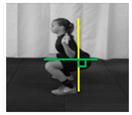
|
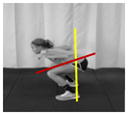
|
□ | Neuromuscular Strength Mobility |
|
| ➉ | Ascent: | Shoulders and hips rise at the same, constant speed to return to start position. Ascent: Descent timing ratio is at least 2:1. |
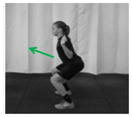
|
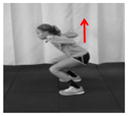
|
□ | Neuromuscular Strength Mobility |
|
| Total: | |||||||
The Back Squat Assessment
The authors of this commentary developed the proposed Back Squat Assessment (BSA) (Table 1) screening tool to assist practitioners in systematically identifying specific functional deficits to guide targeted corrective intervention. The authors propose that observed movement impairments or deficits via guidance of the BSA suggests that an individual may have an elevated injury risk and sub-optimal physical performance.(4) Moreover, the BSA is a versatile tool that provides an alternative means to expensive and sophisticated laboratory evaluation to identify biomechanical deficits.
Ten criteria to be scored are provided in the BSA, which are subcategorized into three comprehensive domains: Upper Body, Lower Body, and Movement Mechanics (Table 1). The three domains are integrated into the BSA to improve the systematic assessment of the back squat. It may be challenging to score all 10 criteria of the BSA at once during real-time observation. The categorization of similar criteria into three domains offers a practitioner a strategic guide to focus attention on scoring one domain at a time. The Upper Body domain emphasizes the stability and posture of the head, neck, and torso. The Lower Body domain assesses the joint positions of the hips, knees, and ankles during the squat. Lastly, the criteria in the Movement Mechanics domain assess the timing, coordination and recruitment patterns of the back squat. All 10 criteria from the three domains can be individually assessed for neuromuscular, strength, and mobility deficits as prompted on the BSA score sheet (Table 1).
To initiate the assessment, the athlete should be asked to perform 10 continuous back squat repetitions. The BSA will necessitate analysis from the anterior, posterior, and lateral perspectives and therefore it may be advantageous for practitioners to record video of the athlete performing the BSA from all three perspectives to facilitate a more accurate and thorough deficit screening.
The criteria are written in the affirmative and each should be critiqued and scored independently of each other. If a single criterion is not met to standard, an observed deficit should be marked. Next, the practitioner should indicate if they believe the deficiency is related to a neuromuscular, strength, or mobility limitation by circling the respective category to guide targeted exercise corrections (Part 2). If unsure, mark all categories that are suspect to improper technique. A perfect score of 0 indicates 10 flawless squat repetitions. A deficit should be marked if the individual fails to demonstrate the desired technique of a criterion to perfection during 2 or more repetitions. Additional space for comments is provided on the score sheet and may be useful for a practitioner make supplementary notes to guide their targeted corrective intervention. An athlete should be referred to a licensed healthcare professional if they indicate pain or discomfort during any phase of the squat assessment.
Standardized Assessment
Back Squat Instruction
For the purpose of maximizing the consistency of the assessment, the BSA should be administered with arm position, stance, and verbal instruction in standardized fashion.
Arm Position Instructions
A light weight cylindrical dowel (wooden, metal, or plastic; approximately 1 ¼″ × 36″ long) is recommended to be used to set-up the athlete in a desired upper torso position while controlling for arm position. Furthermore, the use of a dowel in the back squat position can serve to prepare an athlete for future back squat progressions that incorporates external resistance. In addition, the dowel aided position likely facilitates engagement of the scapular stabilizers essential to upper body performance in the back squat.
Athletes are to be instructed to grip the dowel with a pronated grip slightly greater than shoulder width apart and assume a back squat set-up with the dowel resting comfortably on their contracted upper back musculature. Specifically, the dowel should be positioned across the posterior deltoids just below C7 of the cervical spine. Forearms should be held parallel to the torso and wrists should be kept straight and not flexed throughout the movement (Figure 2). The person should be taught to “bend the bar” (pull the bar into trapezius) as this facilitates the back extensors, shoulder retractors and latissimus – all of which stiffen the torso, adding to injury resilience and performance capabilities. If a dowel is not available, the athlete can be instructed to mimic holding a dowel with their hands open palmed under their ears while retracting their scapulae.
Figure 2.
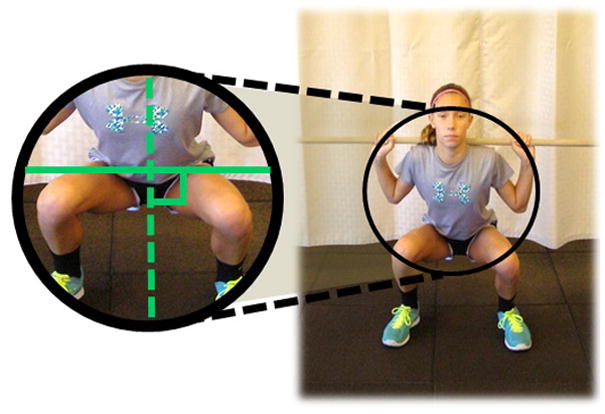
Forearm position with dowel.
Stance Instructions
The athlete should be instructed to assume an initial stance position with heels approximately shoulder-width apart and toes pointing forward or slightly outward by no more than 10-degrees. Extreme stance widths and foot positions (tibial rotation) are not recommended when initially instructing the squat and may limit the utility of the BSA. Escamilla and colleagues assessed the kinematics and kinetics of the squat at three varying widths (a wide stance, shoulder width, and narrow stance).(8) A wide stance may increase patellofemoral and tibiofemoral compressive forces in the knee joint by up to 15% during descent.(7, 9, 43) On the other hand, an excessively narrow stance may increase forward knee translation and therefore heighten anterior shear forces.(7, 43) Therefore, a moderate stance width is encouraged for this standardized assessment.
In regard to foot position, it is important for the knee to function in its intended role as a hinge joint. During goal-specific squat exercise, moderate variations of foot placement may be warranted; however, it is recommended that athletes do not exceed 30 degrees of internal ankle rotation or 80 degrees of external rotation to maximize stability and promote normal patella tracking.(21, 43) Still, extreme tibial rotation in a closed chain movement may potentially lead to increased stress on the static knee structures and should be avoided for most squat variations.
Script for Instructing the Assessment
Once the athlete is properly set-up with the dowel and stance in the appropriate position, verbal instructions for the BSA can be delivered. The authors recommend utilizing the following standardized verbal script to promote inter-rater reliability for the BSA:
“Please stand upright with feet shoulder width apart. Squat down until the top of your thighs are at least parallel to the ground, and then return to the initial starting position. Perform 10 continuous repetitions at a consistent, moderate pace or until you are instructed to stop.”
Set-Up Summary.
Arm Position
A dowel is held in back squat position with forearms parallel to torso and upper back musculature contracted
Stance
Feet are placed with heels shoulder width apart and toes forward or slightly outward.
Script
“Please stand upright with feet shoulder width apart. Squat down until you believe that the top of your thighs are parallel to the ground, and then return to the initial starting position. Perform 10 continuous repetitions at a consistent, moderate pace, or until you are instructed to stop.”
Domain 1: Upper Body
Domain 1 is focuses on the musculoskeletal components of the upper body that are responsible for maintaining postural control during the squat.
1. Head Position
As a precursor to sports performance training for youth, the neck should demonstrate adequate physiological ranges of motion of flexion, extension, rotation, and side bending in absence of pain or discomfort. Simple neck rolls and head tilts can be used as an assessment for neck mobility. If an athlete indicates pain or discomfort when attempting to achieve physiological ranges of neck motion, it is advised to abstain from training and refer the individual to a licensed healthcare professional.
Maintaining the head and neck in neutral alignment (to slight extension) with the torso is an important facet to provide the athlete with a strong, balanced set-up and point of reference throughout the squat.(6) Incorrect positioning of the head and neck may negatively cascade into improper spinal positioning and tracking throughout the range of the movement.(6) In theory, the spine, although comprised of many vertebral links, acts as a single entity. A change in alignment in one section of the spine may influence compensation in another section. Furthermore, poor body alignment as a result of incorrect head position may predispose an athlete to injury during more intense squat exercises.(6, 15)
Practitioners should be aware that head position and gaze direction (focal point) are related but independent. Gaze can be directed by keeping fixed eyes and moving the head, or by moving the eyes independently of a fixed head.(6) Both head position and gaze have been shown to influence spinal kinetics and kinematics.(43)
Desired Technique
Head Position
The athlete’s head should be maintained in a neutral position (to slight extension) in relation to the spine (Figure 3). The neck should be held in line to the plane of the torso.
Figure 3.
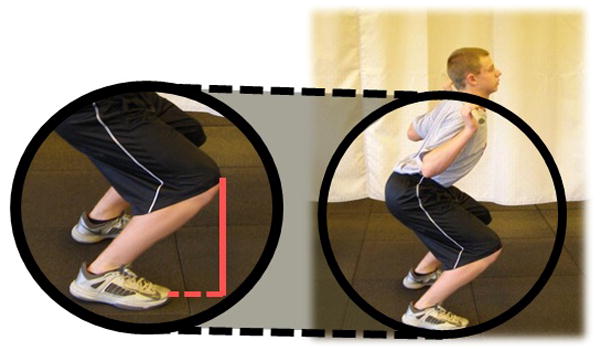
Correct Head Position
Gaze
Point of focus for gaze is instructed to be either straight ahead or slightly upward (Figure 3).(6) It is hypothesized that athletes may have a tendency to move in the direction of their gaze and therefore a downward gaze is not recommended during ascent. A slightly upward gaze during ascent may help guide an athlete to lead with their head and chest rather than raising their hips first when beginning the concentric portion of the squat. In addition, a slight upward gaze throughout the movement may help prevent excessive forward trunk flexion.
Screening
Observe the athlete’s head position from the lateral perspectives. From the lateral perspective, chin position and anterior/posterior head tilt can be observed. From the anterior perspective, assess the athlete’s direction of gaze.
Common Deficits
Head Position
Most athletes will be able to achieve proper head position during the initial set-up phase for the squat. Muscle strain or injury to the cervical vertebrae during exercise may result from improper neck position. Therefore, movement of head too far forward or backward as well as movement of head laterally to either side should be explicitly avoided. Excessive tilting of the head backward into a position of extreme cervical hyperextension can be dangerous during the squat, particularly when heavy resistance is integrated.(2) Excessive cervical hyperextension may be a compensatory movement for a lack of thoracic extension. Excessive cervical flexion may also result in a greater tendency to extend the lumbar spine, which can increase lumbar compression forces (Figure 4). Conversely, if head position is directed too far downward into cervical hyperflexion, a significant increase in hip and trunk flexion may result as a compensation mechanism, which is not considered an optimal movement strategy for the back squat and other sport activities such as tackling in football.(6) From the posterior perspective, ensure that the athlete’s neck position is perpendicular to the line of the shoulder and there is minimal lateral head tilt in either direction. If an athlete is unable to maintain his or her head and neck in a neutral position throughout the entire squat, the deficit may either be due to neck muscle weakness (i.e., trapezius muscles) or inadequate postural awareness.
Figure 4.
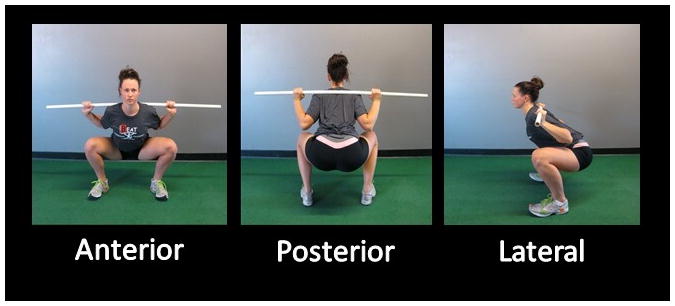
Incorrect Head Position
Gaze
Gaze can either be directed too high or too low. A downward gaze has been shown to increase hip flexion and potentially trunk flexion in comparison to an upward gaze (Figure 4). This position may place increased torque on the vertebral column.(2, 6, 43) However, it is important to disassociate gaze from head position. Although gaze can be slightly upward, the head position should not deviate from neutral. Most errors concerning gaze direction can be corrected via verbal and visual cueing.
Head Position Deficits.
Neuromuscular
Unsatisfactory head and neck position awareness for maintaining neutral head position throughout squat. Poor disassociation of gaze from head position, which may encourage deviation from neutral head position.
Strength/Stability
Insufficient isometric strength of neck and upper back musculature to maintain head in neutral alignment throughout the entire squat.
Mobility
Insufficient physiological range of motion for head and neck in all three planes.
2. Thoracic Position
The athlete must be able to demonstrate adequate postural stability and control of the upper torso as optimal squat technique favors a rigid spine that does not concede to any planar motion. Stable, upright posture should be sustained throughout the movement as a more vertically positioned upper spine, contracted upper back musculature, and chest up position reduces shear forces on the intervertebral disks.
Desired Technique
It is preferred that the thoracic spine is slightly extended and held rigid.(3) The chest is directed outward and upwards to bring the torso angle to a more vertical position,(3) and this position should be maintained throughout the entire squat movement. The chest can be positioned upward independently of trunk angle (criterion 3). The scapulae should be held retracted and depressed while the glenohumeral joint maintains a position of relative external rotation, which pushes out the chest and keeps the upper torso erect (Figure 5). As a result, the shoulders will assume a slightly rolled back position. The athlete’s forearms should be held parallel to their spine and the shoulders should be retracted and not rolled forward. This position allows for major supporting back muscles (i.e., latissimus dorsi, erector spinae, trapezius, rhomboids) to contribute maximally to spinal stability.(28) In addition, a tight upper back with retracted scapulae can help provide the athlete with a favorable position to rest the dowel in the most secure and comfortable manner during back squats.(28)
Figure 5.
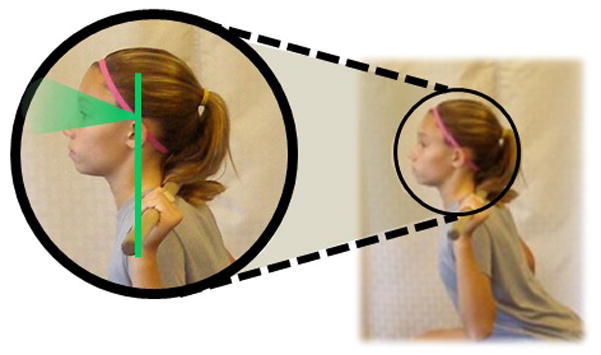
Correct Thoracic Position
Screening
Observation of the upper spine and chest position can be made primarily from the lateral perspective.
Common Deficits
A thoracic position in which the chest is not held upward and is positioned toward the ground signifies a deficit in the back squat technique (Figure 6). In addition, any flexion or excessive extension of the thoracic spine, either constantly or sporadically, may be indicative of biomechanical compensatory strategies.(3) Another deficit of the upper torso is that the scapulae are relaxed or abducted (i.e., ‘protracted scapula’) and visually evidenced as having the shoulders rolled forward. If verbal or physical cueing to instruct the athlete to position their chest up or retract their shoulders does not gain desired technique, then the athlete may lack adequate torso strength, such as the thoracic paraspinal musculature or parascapular musculature, or insufficient neuromuscular coordination to perform the exercise to standard. A propensity for forward rolled shoulders during the back squat may also be due to lifestyle-induced postural weaknesses (i.e., upper crossed syndrome, which results from consistently internally rotated shoulders leading to excessively shortened or tight pectorals).
Figure 6.
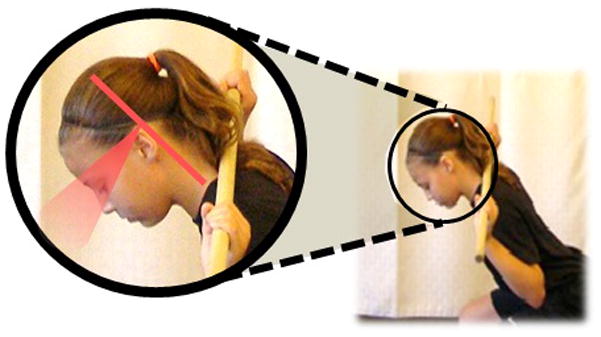
Incorrect Thoracic Position
Thoracic Position Deficits.
Neuromuscular
Chest down or lack of scapular retraction during squat. Difficulty dissociating the thoracic position from the lower trunk position.
Strength/Stability
Inability to maintain chest- up position, which may be due to weakness of erector spinae, trapezius and rhomboids.
Mobility
Excessive tightness in chest, potentially from upper crossed syndrome, which hinders ability to open chest and retract scapula.
3. Trunk Position
Trunk stability and control are derived from the lower back musculature, obliques, lumbar paraspinals, quadratus lumborum, and abdominals. The body’s core is a critical modulator of lower extremity alignments and loads during dynamic tasks such as squatting.(33) The stabilizers of the trunk and hip can preactivate to counterbalance unwanted trunk motion and regulate lower extremity postures during the squat.(33) Decreased core stability and muscular synergism of the trunk and hip stabilizers negatively affect performance in power activities and may increase the incidence of injury due to lack of control of the center of mass.(14, 33) The squat exercise can help instill mechanics that improve trunk stability during dynamic tasks.
Stability during the squat is enhanced with muscular stiffness of all muscles around the lumbar spine. Failure to stiffen the lower back musculature, combined with poor lifting mechanics, increases the potential to overload spine and back tissues to the point of injury, especially when repeated over time.(27, 29) A more upright lumbar posture increases load onto lower extremity levers, which may reduce low back stress. Some may dismiss the need to preserve the neutral curvature of the lumbar spine when squatting. However, this is problematic as the spine loses its ability to bear load when the neutral curve is lost, which prevents eventual progression of the squat with load while maintaining a reduced injury risk. In summary, the individual must demonstrate the ability to maintain a stiffened torso with a neutral, lordotic lumbar position as a safe and optimal squat strategy.
Desired Technique
The lumbar vertebrae are maintained in a neutral alignment throughout the entire squat movement.(28) This entails maintaining a slight lordotic curve in the lumbar region while holding the abdomen upward and rigid to promote stability (Figure 7). The trunk should remain as upright as possible during the squat to minimize lumbar shear forces associated with forward lean.(28) Furthermore, the trunk should remain stable throughout the squat without any observation of wavering or displacement. A general guideline to ensure adequate trunk posture is to necessitate that the line of the trunk is maintained parallel to the line of the tibias from the lateral perspective. However, this guideline also necessitates proper foot and knee position.
Figure 7.
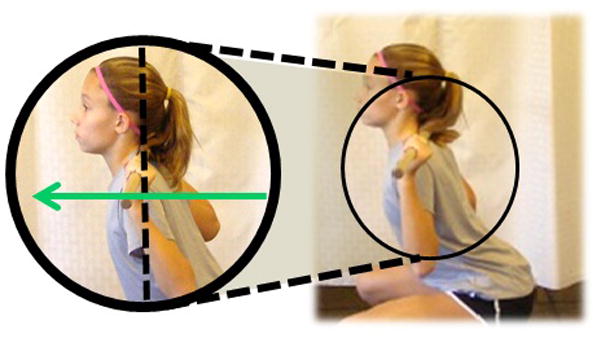
Correct Trunk Position
Screening
Observation of the lumbar spine and trunk angle can be made primarily from the lateral perspective.
Common Deficits
It is sub-optimal for the trunk musculature to be in a relaxed state and allow the trunk to collapse downward into excessive trunk flexion (Figure 8). The muscles form a guide wire system that prepares the flexible spinal column to bear load and they must be activated. Common culprits for increased trunk flexion during the squat are weakness of the thoracic and lumbar paraspinals (erector spinae), weakness of the parascapular musculature to maintain retracted and depressed scapulae as well as reduced tension in the thoracolumbar fascia through the integration of the posterior chain and back musculature. In addition, restricted translation of the knees during the squat may also increase anterior forward lean of the trunk.(16) A trunk that is unsteady and moves out of an upright position during the squat may be indicative of general core weakness.
Figure 8.
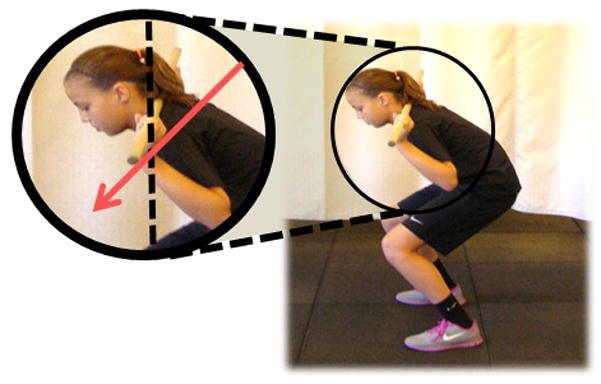
Incorrect Torso Position
The squat requires sufficient spinal mobility to assume and maintain slight lordotic posture. Otherwise, an individual may tend to take forward posture and place excessive pressure to the lower back, especially if their head is tilted forward as well. Insufficient hip mobility may also negatively affect the ability to preserve a lordotic spine, which may be due to genetics, prior injury, or tight connective tissues. If the athlete flexes at the spine before 120° of hip flexion when squatting, they may have restriction in the posterior fibers of the illiotibial band or lack of lumbar control.
Observation of a rounded spine, or kyphosis, due to relaxed back musculature and spinal flexion indicates a deficit for the BSA (Figure 8). If an athlete does not stiffen the back musculature to support the spine positioned in a neutral, slightly lordotic position, increased and potentially harmful compressive and shear forces of the lumbar spine may result during more intense squat variations.(28) The risk of disc herniation is increased during heavy resistance squatting with the spine in a flexed position as a result of excessive stress placed on intervertebral discs.(26, 43)
The most critical component to correcting a deficit with the lumbar spine and abdomen is identification of the mechanism driving the failure to desired technique. Due to the complex nature of this area, one, or a combination of problems could exist. Having the athlete execute a squat to at least parallel with only a dowel as the external resistance will allow the coach to gauge when and if the athlete presents a movement pattern including excessive anterior or posterior pelvic tilt. If the athlete is unable to maintain a slight lordotic curve in the lumbar spine and keep the trunk angle parallel with the tibial angles, then specific corrective actions should be taken (Part 2).
Trunk Position Deficits.
Neuromuscular
Excessive trunk flexion and/or rounding (kyphosis) of the spine during the back squat.
Strength/Stability
Inadequate core strength to maintain torso parallel to tibias and lack of lower back tightness to generate spinal stability. Deficit may be due to trunk extensor weakness and hip extensor weakness.
Mobility
Excessive hip flexors (iliopsoas) and trunk flexors (abdominals) tightness and/or lack of lumbar spinal mobility.
Domain 2: Lower Body
Domain 2 encompasses the musculoskeletal components and positions of the three major joints of the lower extremities during the back squat.
4. Hip Position
The hip joint is a ball-and-socket joint capable of motion in all three planes. It is responsible for providing a pathway of the transmission of forces between the lower extremities and the pelvis during squatting.(43) Evidence suggests that maintaining a neutral pelvic tilt during the squat increases activity of the erector spinae and oblique muscles, helping to ensure optimal muscular support for the spine while handling loads, thereby reducing the risk for low back injury.(5)
The gluteus maximus is the largest muscle of the hip. During the squat movement, the gluteus maximus extends the femur and stabilizes the pelvis.(43) The squat can be an effective training exercise to promote the development of gluteal strength, which is important for athletes as these muscles are prime movers in dynamic sports related movements such as running and jumping.(33) Furthermore, without proper recruitment of the gluteal muscles, other muscle groups such as the quadriceps, must bear the load of the squat, which is suboptimal and may increase the risk of muscle imbalance and injury. The hamstrings are an assemblage of three muscles, including the biceps femoris, semitendinosus and semimembranosus, which originate on the pelvis and insert at the tops of the bones of the lower leg.(43) Since the hamstrings cross both the hips and knees, they moderate movements at both joints.(33) During descent, the hamstrings can assist the gluteal muscles by controlling flexion at the hips.(43) In the ascent phase of the squat, the hamstrings contract to extend the hips. The hip adductors, muscles on the inner thigh, stabilize the femurs during the squat. They prevent the knees and hips from rotating inward during descent.
Desired Technique
The athlete maintains square, stable hips with minimal mediolateral movement during the squat (Figure 9). Squat depth should be determined based on the position of the hips.(2) The position of the femurs should remain symmetrical throughout the entire exercise.(2) It is optimal if the line of the hips from the frontal perspective is parallel to the ground. The athlete is also encouraged to maintain the pelvis in normal/neutral tilt, particularly during the descent phase of the movement. This is particularly important in the final part of the descent.
Figure 9.

Correct Hip Position
Screening
A deficit can be identified by observing the athlete leaning, dropping or twisting to one side from the anterior or posterior perspective.
Common Deficits
Observation of mediolateral rotation or unilateral dropping, which results in asymmetrical hip movement, constitutes a deficit of the hip position. This deficit is evident if the line of the hips is not parallel to the ground in the frontal plane(Figure 10). Hip asymmetries may be due to weaknesses, muscle imbalances in the gluteal complex, or joint asymmetries involving the hip capsule and labrum. It has been reported that an athlete lacking hip mobility will demonstrate a compensatory movement pattern of increased trunk flexion.(3) Hip position deficits can be noted through observations of one hip lower positioned lower than the other in the frontal plane or observation of the dowel dropping down to one side during the squat.
Figure 10.
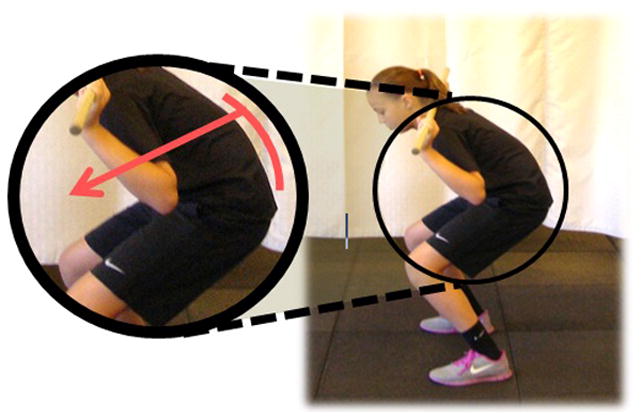
Incorrect Hip Position
Hip Position Deficits.
Neuromuscular
Hips are asymmetrical in frontal plane during the back squat.
Strength/Stability
Lack of strength or stability of hip musculature or asymmetrical strength of hips.
Mobility
Lack of hip flexor range of motion.
5. Frontal Plane Knee Alignment
Internal knee force response to external loads are primarily generated by the quadriceps, hamstrings, and gastrocnemius.(43) Tibiofemoral compressive forces help resist anteroposterior shear forces and translation.(43) Tibiofemoral and patellofemoal compression has been shown to increase with increasing knee angle as a protective function at the knee by initiating a co-contraction between the quadriceps and hamstrings.(43) Therefore, closed kinetic chain exercises such as the back squat exercise may support appropriate rehabilitation exercise post ligament reconstruction surgery.(16) Although shear forces tend to increase with increasing knee angles, forces on the cruciate ligaments of the knee decrease at high flexion angles.(43) Thus, there is no known evidence to support the contention that squat depth below parallel increases the potential for injury to the cruciate and collateral ligaments and menisci in the knee during deep flexion.(43) Training with the squat exercise may enhance passive and dynamic knee stability in deep knee flexion positions via active muscular protection of the passive structures during sport movements.(7, 8, 19, 39)
Desired Technique
The knees should track over the toes throughout the squat motion visually evident as a neutral frontal plane knee position throughout the movement (i.e., the foot is positioned to create a perfect in-line hinge with knee motion). There should be an absence of knee displacement both medially and laterally. The lateral aspect of the knee should not cross the vertical plane of the medial malleolus when assessing for medial displacement (Figure 11). While the goal position is to have the tibia in vertical alignment perpindicular to the floor with error towards lateral knee positions, the medial aspect of the knee should also not cross the vertical plane of the lateral malleolus.
Figure 11.
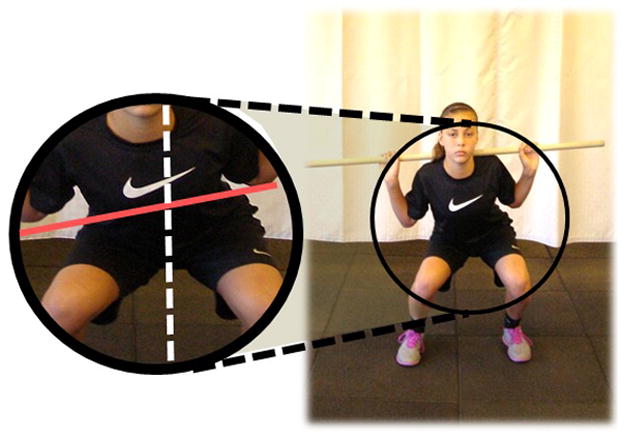
Correct Frontal Knee Position
Screening
Observe excessive mediolateral movement of the knees from the anterior perspective (i.e., knock kneed position).
Common Deficits
Excessive mediolateral movement of the knees signals a functional deficit. Valgus or varus frontal plane movement can be attributed to poor neuromuscular control and lack of function or strength of the lower extremity musculature, especially the posterior chain complex. Knee valgus (medial or knock-kneed movement) during the squat may be influenced by decreased hip abductor and hip external rotation strength, increased hip adductor activity and restricted ankle dorsiflexion. (4) Observed valgus during the squat may due to a suboptimal active neuromuscular pattern of the athlete. Active valgus, which is a position of hip adduction and knee abduction as a result of muscular contraction, is often the underlying cause for observed dynamic valgus during the back squat. From an observational standpoint, medial knee motion is a much more common deficit relative to knee varus (outward movement of the knee). However, knee varus can occur and is sometimes a compensatory strategy employed by athletes with flat feet. A neutral knee alignment is desired and feedback should be given to correct varus or valgus positioning during the movement. Knee valgus can be identified by observation of the medial aspect of either knee passing the medial malleolus from the anterior perspective during any phase of the squat (Figure 12).
Figure 12.
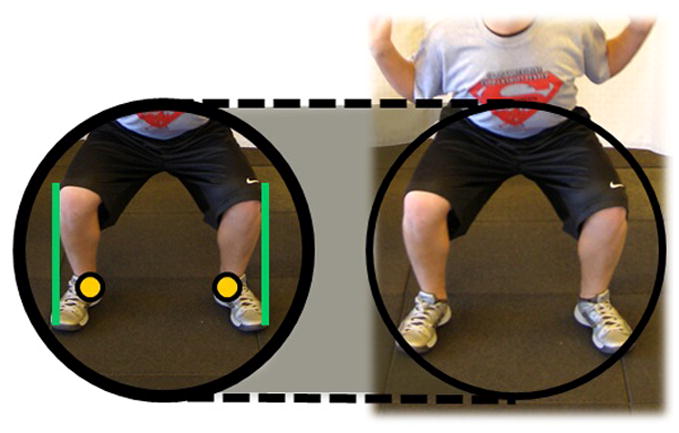
Incorrect Knee Position
Frontal Knee Position Deficits.
Neuromuscular
Active valgus during the back squat; increased hip adductor activation without adequate posterior chain control and recruitment may lead to knee valgus.
Strength/Stability
Posterior chain weakness which leads to passive valgus during squat motion.
Mobility
Hip immobility that restrict knees from avoiding valgus position during squat.
6. Tibial Translation Angle
As a general rule, increased anterior tibial translation increases torque about the knee joint. (16) Although this observation has led some practitioners to caution against allowing the knees to travel past the toes, there is no known evidence that a defined point exists whereby injury risk exceeds the potential benefits during the squat exercise. Moreover, a conscious effort to restrict forward translation has been shown to increase forward trunk lean, resulting in significantly greater forces at the hip and spine that place these joints at greater risk of injury. (16, 23) Thus, on the proviso that feet remain firmly fixed on the floor, anterior tibial translation angle should be unrestricted with the focus on initiating the squat descent by breaking the hips back. (16) Adequate tibial translation angle is able to be achieved via normal foot and ankle capsular mobility, soft-tissue flexibility and proper joint mechanics.
Desired Technique
Although the general goal should be to maintain a positive shin angle, this objective should be accomplished by proper hip joint kinematics. (16, 45) The knees therefore should move freely in accordance with hip range-of-motion. The extent of anterior tibial translation will vary between individuals depending on anthropometrics, in particular the torso and leg length ratio. As a general guideline, the athlete should attempt to match tibia angle in parallel with an upright trunk, while keeping their heels on the ground (Figure 13).
Figure 13.
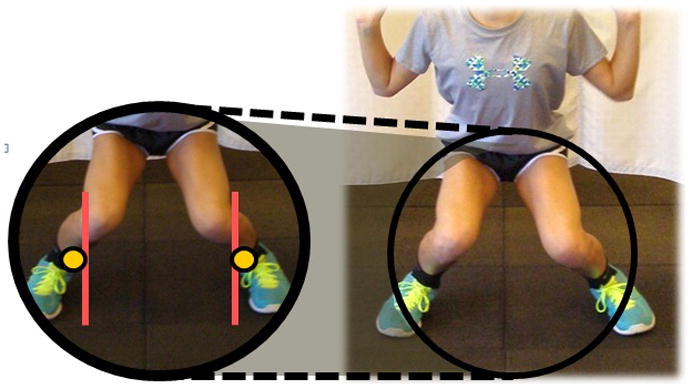
Correct Tibial Translation
Screening
Observe tibial translation from the lateral perspective.
Common Deficits
Athletes may either demonstrate excessive translation or excessive restriction of the tibial progression angle (Figure 14). Excessive anterior translation of the knees over the toes is purported to increase shearing forces on the knee and as well as greater knee extensor torque. (30) Overly restricted tibial translation during the squat increases anterior lean of the torso, which accompanies increases in hip torque and lumbar shear forces. (16) The optimal position of tibial progression angle may support active muscular recruitment of the lower extremity while avoiding unwanted stresses on the passive structures. Often weak gluteal muscles influence the body to use a strategy to alternatively place load on the knees increasing tibia progression rather than on the rear. (33) Excessive tibial progression angle can also be exacerbated by weakness in calf and soleus, weak hamstrings, or quadriceps dominance. Restricted motion of the gastrocnemius and soleus muscle complex via the Achilles tendon, talocrural joint restrictions at the posterior ankle, restrictions in hip mobility, and deficits in foot mobility may also hinder proper tibial progression angle. An evaluation by a licensed healthcare provider may be necessary if a good stretching and mobility routine for the posterior calf musculature does not improve proper performance.
Figure 14.
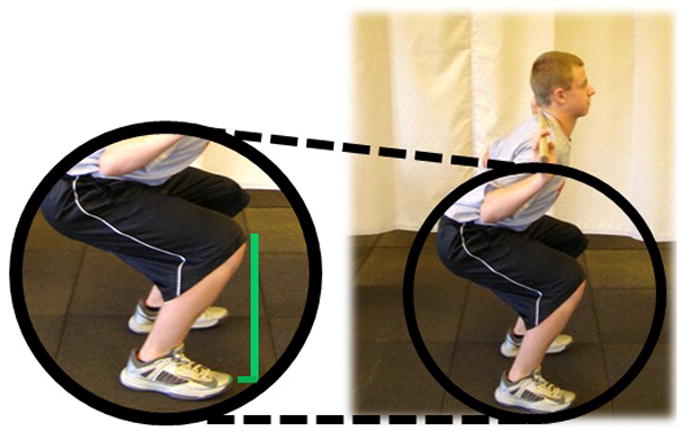
Incorrect Tibial Translation
Tibial Translation Angle Deficits.
Neuromuscular
Knee translates excessively over toes during the back squat, even with heel on the ground.
Strength/Stability
Lack of strength of posterior chain, particularly the gluteals, to keep load on the rear. Excessive tibial progression angle can be a result of weakness in calf and soleus, weak hamstrings, or quadriceps dominance.
Mobility
Inadequate mobility of knee in sagittal plane from lack of mobility of the soleus and gastrocnemius.
7. Foot Position
Adequate ankle mobility supports a balanced and controlled squat movement. However, foot and ankle position can be influenced by proximal forces as well, which may need to be ruled out to determine the cause of the movement deficit. The ability of the athlete to maintain a flat and stable foot position during the back squat necessitates adequate ankle dorsiflexion. (3)
Desired Technique
Ensure the athlete’s feet are stable and planted firmly on the ground. The athlete should keep their entire foot on the ground throughout the entire squat motion (Figure 15). The suggested center of pressure in the foot moves from the mid-foot during initial stance toward the heel and lateral foot (“L” foot loading position) during the descent phase of the squat, and bodyweight is distributed through the lateral foot and heel until the athlete completes the ascent. (3) As the athlete descends, body weight should be emphasized through the heel and lateral foot while keeping the toes on the ground to ensure balance. Placing more body weight towards the back of the foot facilitates desired hip motion strategies during the entire squat phase. In addition, placing more body weight toward the lateral aspect of the foot encourages improved recruitment of the gluteal muscles.
Figure 15.
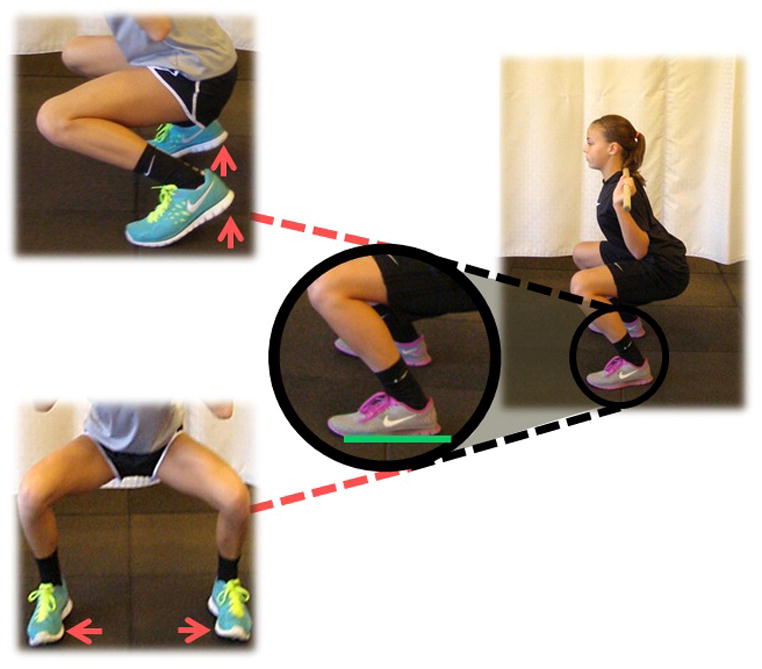
Foot Position
Screening
Observe foot position from the lateral, anterior, and posterior perspectives to assess for any aspect of the foot coming off of the ground.
Common Deficits
Observations of pronation or supination of the feet as well as the rolling of the feet inward or outward are suboptimal movement strategies. Lifting heels or toes off of the ground at any time is suboptimal during the back squat (Figure 15). Allowing the heels to rise off the ground has been observed to create compensatory torques about the ankles, knees, hips, and lumbar spine. (3) With heels raised off of the ground, the athlete has a smaller surface area and base of support, which may reduce the athlete’s ability to perform a balanced and controlled squat.
Ankle inversion or eversion during the squat is also indicative of a biomechanical deficit. Although pressure should be emphasized toward the lateral side of the foot, the medial side should not come off of the ground to promote balance and stability. The calcaneus should not appear everted relative to the lower leg. (20) Stiffness in the ankle joint from poor dorsiflexion may cause the foot and the knee joints to compensate. (3) These compensations may have a negative impact to foot and knee stability that is needed for correct squat mechanics.
Furthermore, weakness in the ankle musculature has been implicated in faulty movement patterns during the squat. A lack of strength in the medial gastrocnemius, tibialis anterior and/or tibialis posterior decreases the athlete’s ability to control knee valgus and foot pronation motions, and may contribute to excessive medial knee displacement and dynamic valgus. (1) While increasing ankle mobility, and in many cases hip mobility, is the desired endpoint for this deficit, some athletes may benefit initially from the use of a heel block to aid in creating a stable platform and assist in pushing through the heels.
Foot Position Deficits.
Neuromuscular
Foot comes off of ground during squat not due to strength or mobility limitations.
Strength/Stability
Lack of or asymmetrical ankle strength and/or poor stabilization of ankle and foot. Foot rolls onto either side during squat.
Mobility
Lack of dorsiflexion mobility if heels come up off ground due to restricted Achilles tendon and/or tight soleus and gastrocnemius.
Domain 3: Movement Mechanics
Domain 3 analyzes the kinematics of the squat and discusses the limitations of functional deficits on proper movement mechanics. Triple extension (extension of ankle, knee and hip) and flexion movement patterns are inherent to sports associated movements such as jumping and landing mechanics.
8. Descent
After achieving a proper set-up, the athlete is instructed to initiate the squat movement with the descent phase. Throughout the descent, the athlete should maintain full control of their velocity and descending position. The athlete should descend by flexing the hip, knees and ankles in a fluid, coordinated movement as the body is lowered in a controlled manner.
Desired Technique
The descent is initiated with the breaking of the hips (‘hip hinging’) while maintaining a rigid, upright trunk. Breaking the hips at the initiation of the squat movement migrates the load to the and posterior chain, which is a more safe strategy for the knees and lumbar vertebrae. (33) The athlete should reach back as if sitting in a chair that is slightly too far away as they descend to the desired depth. The goal should be for the athlete to keep their rear as far away from their ankles while maintaining an upright torso throughout the squat. The vertical distance between the athlete’s shoulders and hips should remain constant throughout the entire descent. Body weight should be transferred to and supported by the athlete’s posterior chain musculature, particularly the hamstrings and gluteals, and not placed anteriorly on their knees (Figure 16). The descent of the squat should move back in a vector that remains at a constant downward angle The athlete should move at a controlled tempo with no less than 2:1 (descent: ascent) up to a 4:1 ratio in regard to velocity of the eccentric movement compared to the concentric ascent phase.
Figure 16.
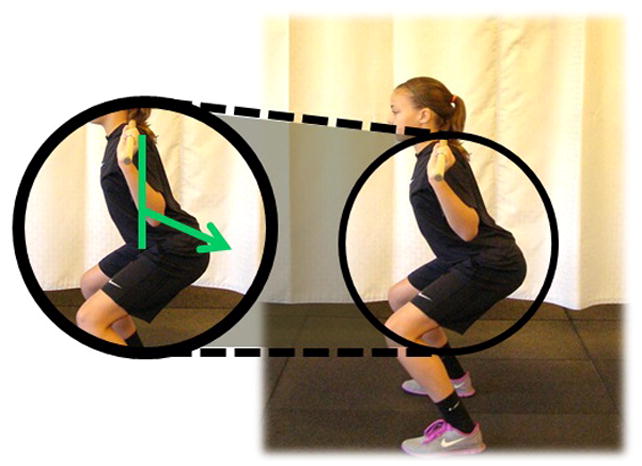
Correct Descent Mechanics
Screening
Observe descent technique and tempo from the lateral perspective.
Common Deficits
Observation of excessively rapid or unsteady movement of the body during descent should be considered a deficit. In addition, incorrect descent mechanics may also be noted if the athlete does not maintain constant speed and control during the entire eccentric phase, which is particularly common in novice lifters. (31) Furthermore, a common mechanical deficit is for athletes to place load down on the anterior aspect of the knees rather than back on the hips during decent (Figure 17). Typically this incorrect strategy can be observed with, but not limited to, excessive tibial progression angle (Criteria 6) and/or heels coming off of the ground (Criteria 7). This incorrect descent strategy may place excessive shear forces on the anterior knee and decreases recruitment of the posterior chain musculature. Athletes with insufficient posterior chain (i.e. hamstrings, gluteals) strength may be more likely to lose descent control toward the later phases of the movement and may favor a knee loading strategy. In addition, more intense squat variations, such as high velocity eccentric movements, can be dangerous if the muscles are forced to stretch too greatly in a short amount of time. Practicing and mastering controlled descent strategies support the development of strategies that can mitigate risk of training induced injuries.
Figure 17.
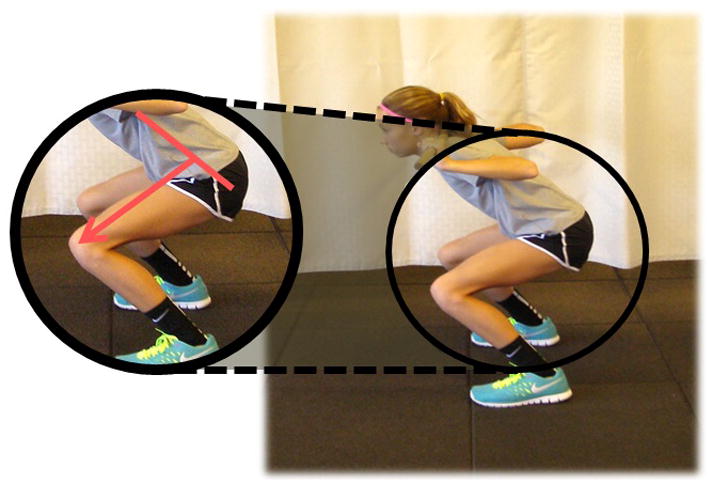
Incorrect Descent Mechanics
Descent Deficits.
Neuromuscular
‘Knee-loading’ strategy instead of ‘hip-hinge’ strategy as seen with excessive trunk flexion, excessive tibial progression angle, and/or heels coming off of the ground.
Strength/Stability
Lack of lower limb eccentric strength control, evidenced by an overall lack of control of the tempo of the descent. The athlete appears to ‘drop’ into the apex of the descent. Descent timing is not 2:1 ratio in relation to ascent.
Mobility
Lack of lower limb mobility, leading to a forward trunk lean.
9. Depth
Squatting to appropriate depth is a critical component in deriving the full benefit of the activity. Without squatting to the proper depth, the hamstrings and gluteus muscular complex may not be adequately challenged. Specifically, training at shallower knee flexion can influence quadriceps dominant sport skill performance that can limit performance and increase injury risk. (19, 39) Likewise, training at deeper depths will help benefit motor control positions that are common to sport. The skill and strength gains achieved during deep knee and hip flexion positions may help reduce quadriceps dominance strategies that are purported to increase injury risk. (18, 37, 38) As noted previously, evidence that indicates squatting below parallel increased the potential for injury to the cruciate and collateral ligaments or menisci in the knee during extreme flexion does not exist. (43) The squat exercise may enhance active knee stability if performed correctly and may reduce sport injury risk to the passive structures of the knee. (7, 8, 39)
Desired Technique
The athlete achieves full depth with the tops of the thighs at least parallel to ground without any disjointed deviations noted at the knee, ankle or hips. At the proper depth, the femurs are slightly past parallel to the ground, hips are back, tibias are positioned vertical, and feet are entirely on the ground (Figure 18). Furthermore, this position allows the squatter to achieve desired depth by not falling victim to soft tissue restrictions such as the thighs blocking the abdomen, thus hindering the ability to achieve an appropriate depth. (2)
Figure 18.
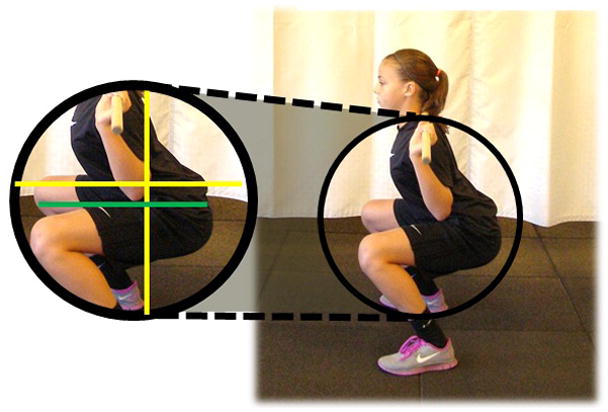
Parallel Squat Depth
Screening
Observe the apex of depth position from the lateral perspective.
Common Deficits
The most common deficit of depth during the back squat is from the athlete squatting too shallow (Figure 19). While squatting excessively past parallel can occur it is not often detrimental to the athlete. If contraindicated based on existing pathology, excessive squat depth can be easily corrected with cueing and feedback. The athlete may lack isometric strength of the posterior chain to maintain bodyweight support at the apex of depth. Furthermore, tightness in the posterior chain musculature and hip adductors may further limit the ability for an athlete to achieve appropriate depth.
Figure 19.
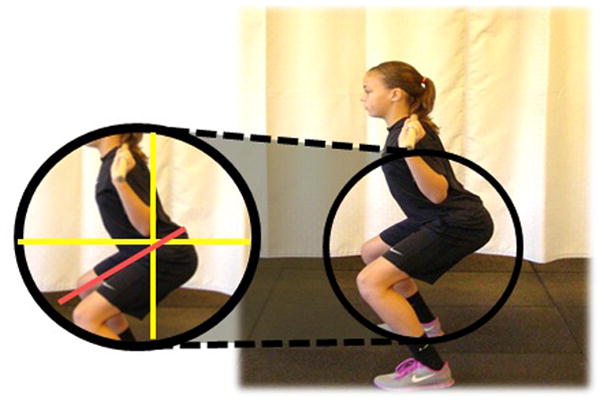
Incorrect Depth
Depth Deficits.
Neuromuscular
Athlete does not achieve depth of thighs at least parallel to the ground.
Strength/Stability
Athlete lacks posterior chain isometric strength to maintain deep hold.
Mobility
Difficulty achieving depth due to tightness in posterior chain and hip adductors.
10. Ascent
The ascent of the squat should follow the same path as the descent in the reverse direction. The primary diver of ascent should be the hips and weight should be kept of the heels and lateral sides of the feet. The torso of the athlete should remain fairly static throughout the ascent as the ankles, knees, and hips extend into the original position.
Desired Technique
The torso should remain upright during the entire ascent phase. The shoulders and hips should rise at the same pace and the difference in vertical height of the shoulders and hips should remain constant (Figure 20). The back is to be kept in a rigid, tight position with stiffened muscles and with the lumbar spine in a neutral to slightly extended position. The athlete should utilize a hip drive strategy as the primary driver for the ascent. The athlete should only exhale once the ascent has been completed.
Figure 20.
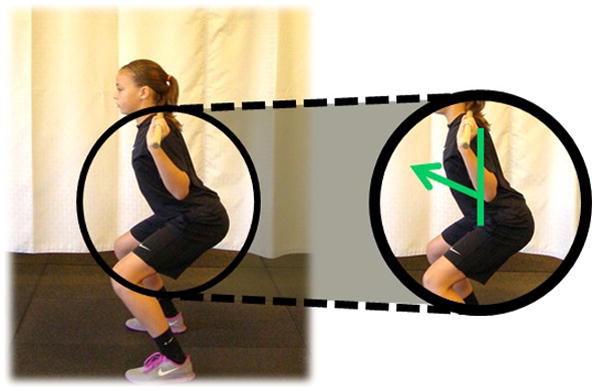
Correct Ascent Mechanics
Screening
Observe ascent technique and tempo from the lateral perspective.
Common Deficits
Common faults in early stages of learning the back squat (i.e., early training age) are for the hips to rise faster than the shoulders, which would increase trunk flexion (Figure 21). If the hips rise too quickly, the vertical distance between the hips and shoulders will decrease during the early ascent phase (Figure 21). Irrespective of the load, the movement pattern represents an incorrect back squat that can be a dangerous strategy to the lower back during squatting with progressive external resistance. In addition, relative to the downward descent, a large deviation in the movement pattern employed during upward ascent is also considered a deficient technique.
Figure 21.
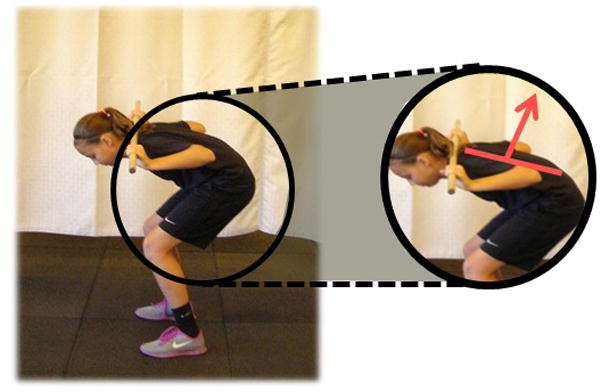
Incorrect Ascent Mechanics
Knee position during ascent may also greatly influence mechanics. If the knees are too far back in relation to the trunk, the athlete is forced to lean forward with their torso to stay in balance. If the knees are too far forward, an acute shift of postural balance occurs, requiring the athlete to shift their body weight onto their toes instead of their heels. This strategy influences an inefficient hip drive out of the transition phase of the movement. Typically, mechanical deficits of ascent are due to sub-optimal motor recruitment patterns that can be improved through neuromuscular training and corrective cueing feedback.
Ascent Deficits.
Neuromuscular
Hips rise too quickly in relation to shoulder during ascent. The vertical distance between the hips and shoulder does not remain constant.
Strength/Stability
Posterior chain and hip extension concentric muscle action weakness.
Mobility
Lack of thoracic spine and hip flexor mobility.
Addional Considerations for the Squat
Anatomical Variation
The proposed form and technique in the 10 BSA criteria are meant to be set as an ideal standard for all athetes. However, it is understood that anatomical variation may predispose some athletes to have disadvantages in achieving these desired positions and mechanics. The factors of anatomical variation most influencing the squat are the anatomy of the hip, together with the ratio of torso length to leg length. The shape of the hip joint determines the type and incidence of specific hip pathology, and squat depth. While a deeper hip joint increases standing stability to the joint, it prevents the femur from flexing into a deep squat without pinching the hip joint labrum and joint capsule. This bony restriction nullifies any attempt to stretch or mobilize the joint to perform the deep squat. Assessment of this feature begins with the individual kneeling on their hands and knees. The knees are initially placed together. Then the pelvis is rocked back towards the heels. The test stops when the neutral spine curvature begins to flex. Then the knees are spread apart a few inches and the “pelvic rock” test is repeated and the depth of the kneeling squat is noted. In this way, the ability to deep squat without compromising the back curvature is quantified, together with identifying the optimal width for the feet and knees when squatting.
Other suggestions for squat safety involve knee loading and whether the knee may be allowed to travel ahead of the toe. This also is a function of the leg length and torso length ratio. A 7 foot tall basketball center usually has longer legs than torso, such that the knees travel way ahead of the toes. The length of the femur creates a long lever and a high patellar tendon load. Generally, these athletes squat with their hips back to balance the knee and hip loads. In contrast, an individual with a longer torso to leg length ratio squats with more emphasis on knee motion, and the shin remains parallel to the torso, equally sharing hip and knee loads.
Integrating the Squat into Athletic Preparation Training
Participation in organized sports does not safeguard youth from developing poor or inefficient movement patterns. Athletes who do not demonstrate proper mechanics may utilize compensatory movement strategies that can hinder their athletic performance and heighten their risk of sports-related injury. (4, 24) In the absence of pressures or cueing during activity to modify these inefficient movements, athletes will continue to master and imprint these suboptimal strategies that will likely propagate into movements utilized in sport competition. Non-athletes with poor squat mechanics will more likely suffer the same fate of eventual pain and sub-optimal performance. The back squat offers an opportunity to teach and instill a correct functional movement pattern providing the foundation upon which to build strength and mobility abilities. For example, it is suggested that the squat reflects lower extremity movement patterns often required for success in explosive sport techniques that are likely to expose the lower extremity to high joint loads. (4) Improved strategies to help young athletes absorb, redirect and create explosive squat related movements can help enhance performance outcomes and reduce injury risk factors. (36, 39) On a more broad level, preservation of the competency to squat can prolong independent living in older adults.
Proficiency with the back squat is a prudent prerequisite to heavy resistance squat training, especially for young athletes with a low training age. (35) An individual should be able to display perfect back squat technique consistently before moving on to more advanced squatting variations including depth jump plyometric training. In addition, by developing proper squat mechanics before utilizing external resistance, an athlete can minimize the potential to instill improper compensatory strategies and decrease the risk of training related injuries. (34) It is outside the scope of this review to discuss the many useful technical variations of the squat movement (i.e., sumo squat, front squat). However, it is advised that athletes do not increase the intensity of the squat (i.e., increase resistance) unless the athlete can demonstrate consistent, proper form of the back squat. Specifically, the back squat is utilized first in the battery of squat variations to teach the parent movement pattern and identify functional deficits. If taught and progressed correctly, technique should remain the same as exercise intensity is increased. Part 2 of the discussion will detail corrective strategies to target specific functional deficits identified during the squat.
It should be noted that the back squat is only one recommended component of a comprehensive neuromuscular training program for youth. Integrative neuromuscular training targeted for the physical development of youth should consider a variety of cognitive- and training-age appropriate exercises to adequately prepare a child for the rigors of moderate to intense physical activity. (34, 40) Integrative neuromuscular training programs for youth should be appropriately designed to meet the needs and goals of aspiring young athletes while considering their current ability level. (24) It is highly recommended that qualified integrative neuromuscular training professionals who understand the psychosocial uniqueness of youth design contribute to the design, supervision and implementation of training programs for young athletes to minimize the risk of training-related injuries and to promote acquisition of sound exercise technique. (24, 34) Integrative neuromuscular training programs for youth are most effective when designed and progressed to be safe and training-age appropriate. (11, 34, 35, 41)
CONCLUSION
The assessment of the unloaded back squat is meant to be a guide for trainers and coaches to identify and target corrections for biomechanical deficits of young athletes prior to participation in more advanced and intense physical training activities. By teaching and correcting optimal form of a basic functional movement inherent to many popular dynamic sports, an athlete can become more sufficiently prepared for the rigorous demands of physical activity. Furthermore, by instilling proper mechanics in youth, individuals may be more inclined to elicit optimal performance gains and reduce injury risk. It is recommended that instructors make careful observations during analysis of the squat assessment. These observations are imperative in developing individualized targeted corrective interventions. Part 2 of this commentary will cover targeted corrective training progressions and methodology for the common deficits for each criterion discussed in this manuscript. (22) Through identification and correction of functional deficits via the bodyweight squat, practitioners can greatly assist young athletes to reap the benefits of improved performance and reduced injury risk to promote successful athletic careers and long-term physical well-being.
Biographies
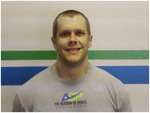 Gregory D. Myer is Director of Research and the Human Performance Laboratory for the Division of Sports Medicine at Cincinnati Children’s Hospital Medical Center and holds primary academic appointments in the Departments of Pediatrics and Orthopaedic Surgery within the College of Medicine at University of Cincinnati.
Gregory D. Myer is Director of Research and the Human Performance Laboratory for the Division of Sports Medicine at Cincinnati Children’s Hospital Medical Center and holds primary academic appointments in the Departments of Pediatrics and Orthopaedic Surgery within the College of Medicine at University of Cincinnati.
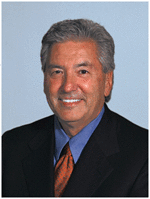 Adam M. Kushner is a Clinical Research Coordinator and Certified Strength and Conditioning Specialist in the Human Performance Laboratory for the Division of Sports Medicine at Cincinnati Children’s Hospital Medical Center.
Adam M. Kushner is a Clinical Research Coordinator and Certified Strength and Conditioning Specialist in the Human Performance Laboratory for the Division of Sports Medicine at Cincinnati Children’s Hospital Medical Center.
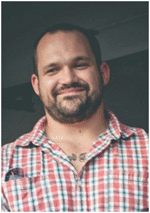 Jensen L. Brent is a Certified Strength and Conditioning Specialist, the owner and director of training at The Academy of Sports Performance in Cincinnati, OH, and head strength and conditioning coach for the Cincinnati Kelts Rugby Football Club.
Jensen L. Brent is a Certified Strength and Conditioning Specialist, the owner and director of training at The Academy of Sports Performance in Cincinnati, OH, and head strength and conditioning coach for the Cincinnati Kelts Rugby Football Club.
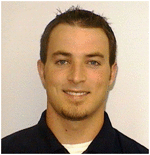 Brad J. Schoenfeld is an assistant professor in exercise science at CUNY Lehman College and director of their human performance laboratory.
Brad J. Schoenfeld is an assistant professor in exercise science at CUNY Lehman College and director of their human performance laboratory.
 Jason Hugentobler is a Sports Certified Specialist by the American Board of Physical Therapy Specialties, Certified Strength and Conditioning Specialist and sports medicine physical therapist at Cincinnati Children’s Hospital Medical Center.
Jason Hugentobler is a Sports Certified Specialist by the American Board of Physical Therapy Specialties, Certified Strength and Conditioning Specialist and sports medicine physical therapist at Cincinnati Children’s Hospital Medical Center.
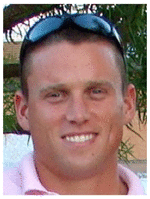 Rhodri S. Lloyd is a Senior Lecturer in Strength and Conditioning at Cardiff Metropolitan University and is a Board Director for the United Kingdom Strength and Conditioning Association.
Rhodri S. Lloyd is a Senior Lecturer in Strength and Conditioning at Cardiff Metropolitan University and is a Board Director for the United Kingdom Strength and Conditioning Association.
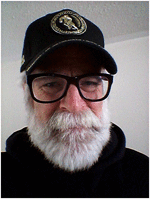 Al Vermeil has been recognized as the only strength coach to have World Championship rings from both the NFL and the NBA and the only strength coach who has been in the NFL, NBA and Major League Baseball. Al was honored by being one of the initial inductees to the Strength Coaches Hall of Fame in June 2003. In 2007, he was honored as one of the initial inductees as a Legend in the Field by the Collegiate Strength and Conditioning Coaches Association and also received the Boyd Epley Award for Lifetime Achievement from the NSCA.
Al Vermeil has been recognized as the only strength coach to have World Championship rings from both the NFL and the NBA and the only strength coach who has been in the NFL, NBA and Major League Baseball. Al was honored by being one of the initial inductees to the Strength Coaches Hall of Fame in June 2003. In 2007, he was honored as one of the initial inductees as a Legend in the Field by the Collegiate Strength and Conditioning Coaches Association and also received the Boyd Epley Award for Lifetime Achievement from the NSCA.
 Donald A. Chu is the Director of the Athercare Fitness and Rehabilitation Clinic in Pleasanton, CA and a Professor and Adjunct Faculty at Ohlone College in Newark, CA.
Donald A. Chu is the Director of the Athercare Fitness and Rehabilitation Clinic in Pleasanton, CA and a Professor and Adjunct Faculty at Ohlone College in Newark, CA.
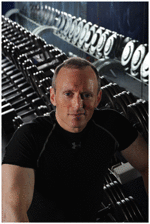 Jason Harbin is the Head Trainer at Beat Personal Training in Cincinnati, OH and is a nationally ranked drug free powerlifter and world record holder in the Squat.
Jason Harbin is the Head Trainer at Beat Personal Training in Cincinnati, OH and is a nationally ranked drug free powerlifter and world record holder in the Squat.
 Stuart M. McGill is a professor of Spine Biomechanics at the University of Waterloo.
Stuart M. McGill is a professor of Spine Biomechanics at the University of Waterloo.
References Cited
- 1.Bell DR, Padua DA, Clark MA. Muscle strength and flexibility characteristics of people displaying excessive medial knee displacement. Arch Phys Med Rehabil. 2008;89:1323–1328. doi: 10.1016/j.apmr.2007.11.048. [DOI] [PubMed] [Google Scholar]
- 2.Branta CF. Sport Specialization: Developmental and Learning Issues. Journal of Physical Education, Recreation & Dance. 2010;81:19–21. 28. [Google Scholar]
- 3.Brocki KC, Bohlin G. Executive functions in children aged 6 to 13: a dimensional and developmental study. Dev Neuropsychol. 2004;26:571–593. doi: 10.1207/s15326942dn2602_3. [DOI] [PubMed] [Google Scholar]
- 4.Clark M, Lucett S. NASM Essentionals of Corrective Exercise Training. 2010. pp. 1–432. [Google Scholar]
- 5.Delitto RS, Rose SJ. An electromyographic analysis of two techniques for squat lifting and lowering. Phys Ther. 1992;72:438–448. doi: 10.1093/ptj/72.6.438. [DOI] [PubMed] [Google Scholar]
- 6.Donnelly DV, Berg WP, Fiske DM. The effect of the direction of gaze on the kinematics of the squat exercise. J Strength Cond Res. 2006;20:145–150. doi: 10.1519/R-16434.1. [DOI] [PubMed] [Google Scholar]
- 7.Escamilla RF. Knee biomechanics of the dynamic squat exercise. Med Sci Sports Exerc. 2001;33:127–141. doi: 10.1097/00005768-200101000-00020. [DOI] [PubMed] [Google Scholar]
- 8.Escamilla RF, Fleisig GS, Lowry TM, Barrentine SW, Andrews JR. A three-dimensional biomechanical analysis of the squat during varying stance widths. Med Sci Sports Exerc. 2001;33:984–998. doi: 10.1097/00005768-200106000-00019. [DOI] [PubMed] [Google Scholar]
- 9.Escamilla RF, Fleisig GS, Zheng N, Barrentine SW, Wilk KE, Andrews JR. Biomechanics of the knee during closed kinetic chain and open kinetic chain exercises. Med Sci Sports Exerc. 1998;30:556–569. doi: 10.1097/00005768-199804000-00014. [DOI] [PubMed] [Google Scholar]
- 10.Escamilla RF, Fleisig GS, Zheng N, Lander JE, Barrentine SW, Andrews JR, Bergemann BW, Moorman CT., 3rd Effects of technique variations on knee biomechanics during the squat and leg press. Med Sci Sports Exerc. 2001;33:1552–1566. doi: 10.1097/00005768-200109000-00020. [DOI] [PubMed] [Google Scholar]
- 11.Faigenbaum AD, Farrell A, Fabiano M, Radler T, Naclerio F, Ratamess NA, Kang J, Myer GD. Effects of integrative neuromuscular training on fitness performance in children. Pediatr Exerc Sci. 2011;23:573–584. doi: 10.1123/pes.23.4.573. [DOI] [PubMed] [Google Scholar]
- 12.Faigenbaum AD, Myer GD. Pediatric resistance training: benefits, concerns, and program design considerations. Curr Sports Med Rep. 2010;9:161–168. doi: 10.1249/JSR.0b013e3181de1214. [DOI] [PubMed] [Google Scholar]
- 13.Faigenbaum AD, Myer GD. Resistance training among young athletes: safety, efficacy and injury prevention effects. Br J Sports Med. 2010;44:56–63. doi: 10.1136/bjsm.2009.068098. [DOI] [PMC free article] [PubMed] [Google Scholar]
- 14.Ford KR, Myer GD, Hewett TE. Increased trunk motion in female athletes compared to males during single leg landing: 821: June 1 8: 45 AM-9: 00 AM. Med Sci Sports Exerc. 2007;39:S70. [Google Scholar]
- 15.Fry A. Exercise Technique: Coaching Considerations for the Barbell Squat-Part II. Strength Cond J. 1993;15:28–32. [Google Scholar]
- 16.Fry AC, Smith JC, Schilling BK. Effect of knee position on hip and knee torques during the barbell squat. J Strength Cond Res. 2003;17:629–633. doi: 10.1519/1533-4287(2003)017<0629:eokpoh>2.0.co;2. [DOI] [PubMed] [Google Scholar]
- 17.Heijne A, Fleming BC, Renstrom PA, Peura GD, Beynnon BD, Werner S. Strain on the anterior cruciate ligament during closed kinetic chain exercises. Med Sci Sports Exerc. 2004;36:935–941. doi: 10.1249/01.mss.0000128185.55587.a3. [DOI] [PubMed] [Google Scholar]
- 18.Hewett TE, Myer GD, Ford KR. Decrease in neuromuscular control about the knee with maturation in female athletes. J Bone Joint Surg Am. 2004;86-A:1601–1608. doi: 10.2106/00004623-200408000-00001. [DOI] [PubMed] [Google Scholar]
- 19.Hewett TE, Myer GD, Ford KR, Heidt RS, Jr, Colosimo AJ, McLean SG, van den Bogert AJ, Paterno MV, Succop P. Biomechanical measures of neuromuscular control and valgus loading of the knee predict anterior cruciate ligament injury risk in female athletes: a prospective study. Am J Sports Med. 2005;33:492–501. doi: 10.1177/0363546504269591. [DOI] [PubMed] [Google Scholar]
- 20.Hirth CJ. Clinical Evaluation & Testing Clinical Movement Analysis to Identify Muscle Imbalances and Guide Exercise. Athletic Ther Today. 2007;12:10. [Google Scholar]
- 21.Hung YJ, Gross MT. Effect of foot position on electromyographic activity of the vastus medialis oblique and vastus lateralis during lower-extremity weight-bearing activities. J Orthop Sports Phys Ther. 1999;29:93–102. doi: 10.2519/jospt.1999.29.2.93. discussion 103–105. [DOI] [PubMed] [Google Scholar]
- 22.Kushner AM, Brent JL, Schoenfeld B, Hugentobler J, Lloyd RS, Vermeil A, Chu DA, McGill SM, Myer GD. The Back Squat: Targeted Training Techniques to Correct Functional Performance Deficits and Teach Proficiency. Strength Cond J. 2015 doi: 10.1519/SSC.0000000000000130. Under Review. [DOI] [PMC free article] [PubMed] [Google Scholar]
- 23.List R, Gulay T, Stoop M, Lorenzetti S. Kinematics of the Trunk and the Lower Extremities During Restricted and Unrestricted Squats. J Strength Cond Res. 2012 doi: 10.1519/JSC.0b013e3182736034. [DOI] [PubMed] [Google Scholar]
- 24.Lloyd RS, Faigenbaum AD, Stone MH, Oliver JL, Jeffreys I, Moody JA, Brewer C, Pierce KC, McCambridge TM, Howard R, Herrington L, Hainline B, Micheli LJ, Jaques R, Kraemer WJ, McBride MG, Best TM, Chu DA, Alvar BA, Myer GD. Position statement on youth resistance training: the 2014 International Consensus. Br J Sports Med. 2014;48:498–505. doi: 10.1136/bjsports-2013-092952. [DOI] [PubMed] [Google Scholar]
- 25.Lubans DR, Morgan PJ, Cliff DP, Barnett LM, Okely AD. Fundamental movement skills in children and adolescents. Sports Med. 2010;40:1019–1035. doi: 10.2165/11536850-000000000-00000. [DOI] [PubMed] [Google Scholar]
- 26.Matsumoto H, Suda Y, Otani T, Niki Y, Seedhom BB, Fujikawa K. Roles of the anterior cruciate ligament and the medial collateral ligament in preventing valgus instability. Journal of orthopaedic science. 2001;6:28–32. doi: 10.1007/s007760170021. [DOI] [PubMed] [Google Scholar]
- 27.McGill SM, Marshall L, Andersen J. Low back loads while walking and carrying: comparing the load carried in one hand or in both hands. Ergonomics. 2013;56:293–302. doi: 10.1080/00140139.2012.752528. [DOI] [PubMed] [Google Scholar]
- 28.McGill SM, Norman RW. Dynamically and statically determined low back moments during lifting. J Biomech. 1985;18:877–885. doi: 10.1016/0021-9290(85)90032-6. [DOI] [PubMed] [Google Scholar]
- 29.McKean MR, Dunn PK, Burkett BJ. The lumbar and sacrum movement pattern during the back squat exercise. J Strength Cond Res. 2010;24:2731–2741. doi: 10.1519/JSC.0b013e3181e2e166. [DOI] [PubMed] [Google Scholar]
- 30.McLaughlin TM, Lardner TJ, Dillman CJ. Kinetics of the parallel squat. Research Quarterly American Alliance for Health, Physical Education and Recreation. 1978;49:175–189. [PubMed] [Google Scholar]
- 31.Miletello WM, Beam JR, Cooper ZC. A biomechanical analysis of the squat between competitive collegiate, competitive high school, and novice powerlifters. J Strength Cond Res. 2009;23:1611–1617. doi: 10.1519/JSC.0b013e3181a3c6ef. [DOI] [PubMed] [Google Scholar]
- 32.Myer GD, Brent JL, Ford KR, Hewett TE. Real-time assessment and neuromuscular training feedback techniques to prevent ACL injury in female athletes. Strength Cond J. 2011;33:21–35. doi: 10.1519/SSC.0b013e318213afa8. [DOI] [PMC free article] [PubMed] [Google Scholar]
- 33.Myer GD, Chu DA, Brent JL, Hewett TE. Trunk and hip control neuromuscular training for the prevention of knee joint injury. Clin Sports Med. 2008;27:425–448. doi: 10.1016/j.csm.2008.02.006. [DOI] [PMC free article] [PubMed] [Google Scholar]
- 34.Myer GD, Faigenbaum AD, Chu DA, Falkel J, Ford KR, Best TM, Hewett TE. Integrative training for children and adolescents: techniques and practices for reducing sports-related injuries and enhancing athletic performance. Phys Sportsmed. 2011;39:74–84. doi: 10.3810/psm.2011.02.1854. [DOI] [PubMed] [Google Scholar]
- 35.Myer GD, Faigenbaum AD, Ford KR, Best TM, Bergeron MF, Hewett TE. When to initiate integrative neuromuscular training to reduce sports-related injuries and enhance health in youth? Curr Sports Med Rep. 2011;10:155–166. doi: 10.1249/JSR.0b013e31821b1442. [DOI] [PMC free article] [PubMed] [Google Scholar]
- 36.Myer GD, Ford KR, BRENT JL, Hewett TE. The effects of plyometric vs. dynamic stabilization and balance training on power, balance, and landing force in female athletes. J Strength Cond Res. 2006;20:345–353. doi: 10.1519/R-17955.1. [DOI] [PubMed] [Google Scholar]
- 37.Myer GD, Ford KR, Hewett TE. Rationale and Clinical Techniques for Anterior Cruciate Ligament Injury Prevention Among Female Athletes. J Athl Train. 2004;39:352–364. [PMC free article] [PubMed] [Google Scholar]
- 38.Myer GD, Ford KR, Khoury J, Succop P, Hewett TE. Biomechanics laboratory-based prediction algorithm to identify female athletes with high knee loads that increase risk of ACL injury. Br J Sports Med. 2011;45:245–252. doi: 10.1136/bjsm.2009.069351. [DOI] [PMC free article] [PubMed] [Google Scholar]
- 39.Myer GD, Ford KR, Palumbo JP, Hewett TE. Neuromuscular training improves performance and lower-extremity biomechanics in female athletes. J Strength Cond Res. 2005;19:51–60. doi: 10.1519/13643.1. [DOI] [PubMed] [Google Scholar]
- 40.Myer GD, Kushner AM, Faigenbaum AD, Kiefer A, Kashikar-Zuck S, Clark JF. Training the developing brain, part I: cognitive developmental considerations for training youth. Curr Sports Med Rep. 2013;12:304–310. doi: 10.1097/01.CSMR.0000434106.12813.69. [DOI] [PubMed] [Google Scholar]
- 41.Myer GD, Lloyd RS, Brent JL, Faigenbaum AD. How Young is “Too Young” to Start Training? ACSMs Health Fit J. 2013;17:14–23. doi: 10.1249/FIT.0b013e3182a06c59. [DOI] [PMC free article] [PubMed] [Google Scholar]
- 42.Myer GD, Paterno MV, Ford KR, Hewett TE. Neuromuscular training techniques to target deficits before return to sport after anterior cruciate ligament reconstruction. J Strength Cond Res. 2008;22:987–1014. doi: 10.1519/JSC.0b013e31816a86cd. [DOI] [PubMed] [Google Scholar]
- 43.Schoenfeld BJ. Squatting kinematics and kinetics and their application to exercise performance. J Strength Cond Res. 2010;24:3497–3506. doi: 10.1519/JSC.0b013e3181bac2d7. [DOI] [PubMed] [Google Scholar]
- 44.Sihvonen S, Sipila S, Taskinen S, Era P. Fall incidence in frail older women after individualized visual feedback-based balance training. Gerontology. 2004;50:411–416. doi: 10.1159/000080180. [DOI] [PubMed] [Google Scholar]
- 45.Swinton PA, Lloyd R, Keogh JW, Agouris I, Stewart AD. A biomechanical comparison of the traditional squat, powerlifting squat, and box squat. J Strength Cond Res. 2012;26:1805–1816. doi: 10.1519/JSC.0b013e3182577067. [DOI] [PubMed] [Google Scholar]


